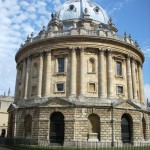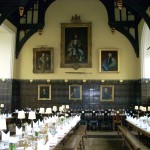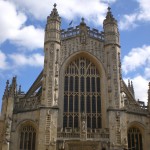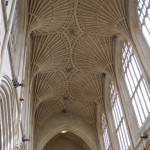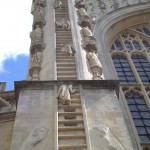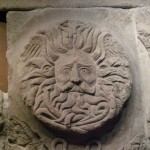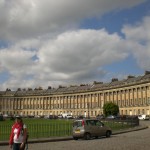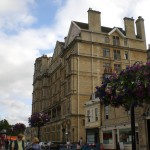On my second day of volunteering at the Norwich Cathedral egg hunt, I was signed up to work with Susanne, another volunteer. She turned out to be a lovely woman, and while we went around delivering Cadbury’s finest chocolate eggs, we chatted about an assortment of things. I learned that she has two daughters, both of whom studied abroad in the States while they were getting their degrees. It was nice to talk to a British “soccer/football mom”. Working with her made me realize that although I have gotten to meet British students and teachers, I haven’t interacted very much with adults outside of academia. There is an entire generation of people we are missing out on. I wonder if that would have been different had the program involved a home stay family.
On a different note, this day was very exciting because our supervisor, Juliet, took us on a tour of the upper level of the Cathedral. This section is not open to the public or even to most members of the church, so it was a great privilege to be invited. We got to walk right underneath the big stain glass windows, so close that I could touch it. We also walked right onto the organ.
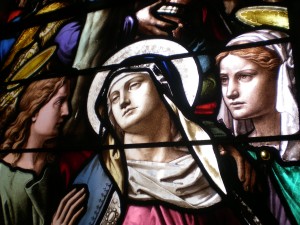
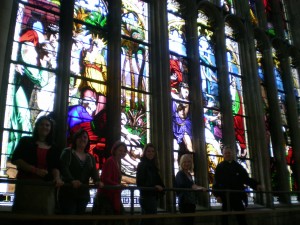
As we walked along each wall of the Cathedral, Stephenie and Juliet explained the significance of a lot of the architecture and some of the more intricate designs. There were carvings in the wall, most of them dated, and we made a game of trying to find the earliest ones. It’s rather mind boggling to think of all that history wrapped up in one building.
Date: 13/4
Supervisor: Juliet Corbett
Hours:10-3 (5)
Total Hours: 9
Tags: 2010 Sarah
September 22nd, 2010 · 1 Comment
As I and many others have mentioned in previous posts, examining religion and religious life in London has been a big part of our course. Central to increasing our knowledge and understanding of a number of religions has been visiting the various houses of worship. We have visited a few churches, a mosque, a mandir, and a synagogue. We have gone into these institutions with varying levels of welcome, and we have observed a variety of rituals, customs, and traditions.
Beauty has also been a recurring theme in the course. Almost all of the houses of worship that we visited had put serious thought and effort into the beautification of their buildings. The only exception was the mosque, but I think it is ok to assume that this was due to the financial circumstances of the community than lack of desire or appreciation for a beautiful space. In addition to all being beautiful, these spaces were all aesthetically very unique. The Mandir was extremely ornate, but not to the point of tackiness or fussiness. All of the stone and teak carvings were well executed and the building as a whole had a feel of luxury to it. The synagogue was a more simple, paired down building, but even as a more streamlined space, it still packed ample visual drama in the floor to ceiling red and gold mosaic behind the ark and tall, dramatic stained glass windows, which unfortunately had to be obscured by anti-terrorism curtains.
Comparing St. Paul’s and Westminster Abbey, aesthetically, St. Paul’s is the clear winner. Westminster Abbey is cluttered with tombs and plaques and statues, it is mostly dark and parts do look kind of shabby. Don’t get me wrong, it’s a place of great historical significance and cultural value, I’m not denying that, but on looks alone…. ehhh. St. Paul’s on the other hand, is light, airy, and spacious. It has a regal, elegant exterior and strikes a nice profile. The mosaics on the ceiling close to the WWII memorial were exceptional. As John explained to us, the tesserae had been set in at a specific angle, not flat against the wall, so that the sunlight reflects off of them just enough to allow them to glint and glitter. Perhaps over stepping here, but I think the visual atmosphere, the aesthetics of the particular houses of worship, reflect something of the character of the congregations who pray there.
Tags: 2010 Rachel · Uncategorized
September 14th, 2010 · No Comments
I think that some of my favorite activities we’ve done since we’ve been here have been our day trips to Bath, Oxford, and Stratford. I don’t think I could ever live in a city permanently; the crowds, the chaos, the push and shove hustle and bustle in London would definitely be too stressful for me to handle on a long term basis. Driving through the countryside on our way to our destinations was a refreshing break for me, and was much more reminiscent of home than our lives in the city. Below is a picture I took through the bus window on our way home from Bath.
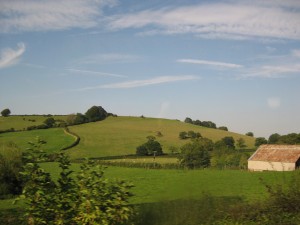
There are several key differences I have observed between London and the smaller cities of Bath, Oxford, and Stratford. Let’s begin with visuals. First is a picture I took from halfway up to the top of Bath Abbey looking out over Bath. Next is a picture I took from the top of St. Paul’s Cathedral looking out over London.
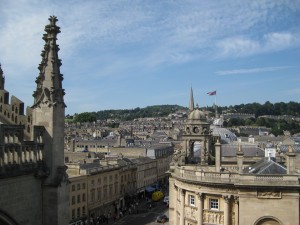

Striking difference, isn’t it? The first major difference I noticed is illustrated by these pictures. London is extremely chaotic, with Gothic churches next to modern office buildings next to museums next to hotels created in Georgian architecture next to parks with no particular rhyme or reason and no grid pattern to the streets. Each of the smaller cities we visited seemed planned. The streets were laid out in straight lines; coming back from the church to the bus in Stratford we were easily able to just reverse our steps and when John said that the coach was straight down this block, it actually was straight, and the name of the street stayed the same all the way down. Houses were grouped with houses and businesses with businesses. You can see this in my photo from Bath – nice rows of houses on the horizon. Finally, each city seemed to have a unifying theme. In Bath, it is the distinctively colored Bath Stone. In Oxford, it is the many colleges. In Stratford, it is the Tudor architecture and the fact that all the streets, hotels, and pubs are named after something Shakespearean. (You could argue that that last theme is a bit kitsch, but still, it is a theme.)
You can also see from the pictures that the buildings in Bath are a lot shorter than the buildings in London. In Bath, the tallest feature is a spire, like it used to be in London. In London, the skyscrapers on the horizon, each one striving to be taller than the last, demonstrates the individualistic capitalism and commercialism that has touched this city more than others. Our day trips have reminded me how London truly is the financial and cultural capital of the world, a place which draws people, a place where things always have to be happening. Bath, Oxford and Stratford seem to be less touched by this globalized commercialism. I did spot a Ben and Jerry’s in Bath, but I did not see Starbucks and KFC’s on every corner like we do in London.
I think that a slower pace of life and a greater appreciation for people goes hand in hand with the softened touch of commercialism in the smaller cities. I think a good example of this contrast is seen by comparing busking in Bath and London. From what I learned from our tour guide in the Bath Abbey, the buskers have their own kind of community. In Bath, you don’t need a license to perform in the streets, but you are only allowed to stay in the same place for one hour before you have to move 50 metres down the street. The buskers regulate this themselves; they form their own queues and rotations for different spots throughout the city. In London, buskers need a license, and they are assigned a specific spot and specific time to perform. It is doubtful that many of them know each other or even cross paths. Furthermore, in Bath, people sit around the squares and actually listen to the busker perform for the entire half hour or hour he is there. In the London Underground, people always hurry right past the performers, barely noticing them. In the smaller cities, I felt like there were actually people, as opposed to the anonymous mass we have observed in London.
Personally, I prefer the smaller towns and cities to London, but they are not without their disadvantages. Obviously, there is not as much diversity to be found in the smaller cites, nor are there are many opportunities for arts and museums as there are in London.
A problem with the argument I have made in this post is that the three smaller cities we’ve gone to have also been very touristy cities. Although I feel as though the observations I have made are accurate, I recognize that they are limited by the presence of tourists queuing for attractions and buying gifts in gift shops. I am excited to move to Norwich, a less touristy town and one in which we will actually get to participate in the communitiy, to see if my observations hold true.
Tags: 2010 Kaitlin
February 26th, 2010 · 1 Comment
Several weeks ago, Audrey, Kelley, Chelsea and I took a tour of the Great Hospital which was given by a member of the Board of Trustees for the Hospital, Pam Petersen. Pam, a vivacious elderly woman with a quirky yet endearing sense of humor, proved to be a wealth of information regarding the Hospital, medieval life, and fun, strange facts about Norwich and Norfolk.

The tour began in the Church of St. Helen, a small, modest church which was, at the time it was built, one of the most impressive church buildings of its kind in the city. As The Great Hospital, originally St. Giles’s, underwent multiple renovations and restorations, certain areas of the church were walled off and transformed into hospital wards. Pam pointed out several interesting features within the Church, including the elaborately decorated vaulted bosses in the chantry chapel, a special stained glass window and carved wooden bench ends. The bosses are all hand-carved, hand-painted, and depict significant biblical scenes. The stained glass window was donated from a church which was largely destroyed during the air raids on Norfolk during WWII. Amazingly, the window survived, and now rests within the walls of the Church. The bench ends were carved by John Hecker between 1519 and 1532, and are fine examples of medieval woodworking.

From the Church of St. Helen, Pam led us into Eagle Ward. Eagle Ward was formed as a result of the renovations previously mentioned, and was converted into accommodation during the mid-fifteenth century, and served as such up until the first part of the twentieth century. The ceiling of the Ward is adorned with 252 tiles, each painted with an eagle. The creation of the ceiling was to celebrate the coming of Anne of Bohemia, the wife of King Richard II, to Norwich. Today, the Ward serves as an exhibit and is preserved to look as it would have in the first part of the twentieth century, complete with tea cups, doilies, reading glasses, bed pans and other period artifacts that would have belonged to the residents who lived there.
We moved on to the Refectory, which is where the priests of the medieval hospital would have taken their meals, and where events, meetings and small banquets are still held today. The ceiling of the hall is supported by exposed beams which feature carved dragons, similar to those which can be seen in nearby Dragon Hall. An antique table stands at the back of the room and was cut from a single tree. The table is very unique and quite valuable, according to Pam. Among other artifacts, including banners and framed documents, the Refectory houses a slightly more grotesque artifact: a goose quarterer. St. Giles’s was known for their annual goose feasts, and even boasted its own swan pit. The walls of the Refectory are lined with photographs of feather-plucking – which was, according to one caption, a social affair – and charts depicting the various branding marks which would be cut into the beaks of the swans.
As we left the Refectory and made our way to the Ivory Room, Pam spoke about the current operations at The Great Hospital. Currently an assisted living facility, the hospital houses 126 residents and offers three different types of care: independent with no care, independent with some care (help with dressing, household chores, etc.) and full care. However, there is no nursing service offered by the hospital.
The Ivory Room, actually a house in its own right, was built and restored by the Thomas Ivory family, with whom the hospital maintained a close relationship. The building is quintessentially Georgian, and features Roman style murals and trompe l’oeil throughout. The Ivory Room is currently undergoing major restoration, but the grandeur of this magnificent building is discernible even through the scaffolding and littering of paint cans and toolboxes. In a room which faces the Norwich Cathedral, painted cherubs adorn the silk-lined ceiling, and the entire celestial scene is lined with crisp crown mouldings.

From this room in the Ivory Room, I looked out onto the steeple of Norwich Cathedral, slightly silhouetted against a pink-grey sky. It seemed like the perfect location – and ambience – in which to end our tour. Before wrapping up our tour, Pam shared with us a recipe for Swan, laughing all the while. We made small talk as she showed us back out to the road, and asked us where we were all from. We answered and Pam responded that the only American geography she knew she had learned from The Simpsons. We, laughed, thanked her and walked along Pottergate, under the Norwich sunset.

Length of tour: approx. 1.5 hrs. Total time logged: 2.5 hrs.
Tags: Anya
September 14th, 2009 · No Comments
In this wonderful blog post, I think I shall convey my experiences at the John Soane Museum. Essentially this museum was founded by Sir John Soane who turned his home into an area in which artists and art lovers alike could come in and appreciate his collection of antiquities.
The overall effect was fairly awesome because this museum has such a variety of artwork, including roman, medieval, neo-classical, and Egyptian works of art. There were some really beautiful statues, pieces of stained glass, paintings, and various other ancient artworks. I also noticed that one of his more famous collections is from ancient Egypt…including a sarcophagus? It’s amazing to me what money can buy if you have enough of it.
Anyways– I just visited the website to get some more background on John Soane himself but there is not an exorbitant amount of detail on his life. They do mention, however, that he was a distinguished architect who designed his own house so that it may become “a museum to which ‘amateurs and students’ should have access”. He left his collection and house to the nation in1837 because after his wife died in 1815 he never remarried and decided to establish the house as a museum.
The museum is architecturally beautiful, filled with illusions and surprises everywhere. I guess my favorite thing about this particular museum was that John Soane had made an effort to share historic art with others, so that no matter one’s circumstance he or she could lay their eyes on ancient relics. This was the one really redeeming quality to this particular museum. Don’t get me wrong, I loved the actual art that was involved but to me, the most important part was that John Soane wanted everyone to benefit from his collection. Maybe by the time I got around to actually visiting it, I was pretty tired of museums in general. Room 26 informed me that they had seen so many museums recently that Jeyla woke up and asked both Anya and Audrey if they were in a museum. Despite the fact that this is a hilarious story and I laugh every time I think about it, I think the moral of what I’m trying to say is that we have visited so many museums that this particular one really didn’t stand out for me, as say, the Tate Modern. Overall, I appreciated the experience but wouldn’t revisit it. On the Brightside for those of you who loved it I think the website as an interactive tour you can take whenever your little heart desires! 🙂
Tags: Maddie · Museums
When people hear the word Oxford, they think of a very selective and highly demanding school. And it’s true; the University of Oxford is an elite institution. However, Oxford usually doesn’t conjure up images of the town itself. I will not deny that parts of the town were beautiful, but many parts were a bit too touristy. At certain points throughout Oxford I felt as if I was just walking through a series of strip malls. Such sights were not what I expected Oxford to look like at all; instead I thought I would be seeing just a picture perfect small college town.
On top of this, those “lucky” enough to have been with a certain tour guide are aware of how boring Oxford can be made to be. I know our tour guide had the best intentions, but the manner in which he toured us around Oxford made me want to fall asleep. If that is a glimpse of the Oxford experience, I’ll gladly take Dickinson.
That said, the colleges of Oxford are amazing. The architecture is beyond belief and to have the opportunity to study at one of the colleges would truly be a privilege. The dining hall we visited was extraordinary and surprisingly cheap to eat at (3 pounds for a meal if I remember correctly). Speaking of prices, I have to say that the price of tuition caught me off guard. To pay only 9,000+ pounds in order to attend this elite institution is something I am still trying to wrap my mind around. If only Dickinson would follow suit…
Something I found particularly interesting was how hostile the university was to the sciences. Having a completely separate science library so that it wouldn’t “infect” the classical studies of the students is fascinating. Though it does make sense now that I think about, I still believe that such an attitude shows just how far we have progressed; science is no longer seen as an enemy (at least by those who can actually think on their own).
In the end, the University of Oxford was truly an awesome experience. Though the tour guide was a bit boring, he still explained the history very well (and made us ponder the universe and infinity). I only wish the town of Oxford itself was less touristy and less ritzy.
Tags: Andrew F
I can honestly say that the day trip to Stonehenge and Bath was one of the best days of my life. First of all, the weather was fantastic and most of my great days start with great weather. Stonehenge was impressive, and I am truly thankful that we were able to visit, but I’m glad it was only allotted one hour of our time. I was really looking forward to the town of Bath, the home of an extremely well preserved Roman Bathhouse, beautiful Georgian architecture and yet another gorgeous Gothic Abbey. As our bus was winding up and around narrow country roads (and I was praying we didn’t run off them) the town came into view. My jaw dropped. In front of me was what appeared to be the quintessentially English country town…. Complete with Jane Austen! Lunch at the Rat and Parrot pub seemed like a good sign, I’ve never been called “dearie” and “love” more times in an hour than I was there. Walking through the bathhouse with my audio guide I learned about the history of the baths and the bathhouse culture of the Romans. While the museum commentary was informative, I ended up listening to Bill Bryson’s commentary rather than the museum. Bryson has a way of making the simplest truth hilarious. Perhaps it’s the way he phrases things, or maybe it’s the delivery. I still don’t know but I was laughing (and, of course learning) the whole time. The case dedicated to the ‘curses’ was especially hilarious. These little tablets were thrown into the waters as an offering to Minerva in hopes that she would grant what they wished. My favorite was the one about the missing cloak, in which the writer wishes all sorts of injury and ill luck upon the man who robbed him. How could this advanced society, this mighty empire, believe that inscribed tablets to the Gods would help them find their misplaces items? These little curses reminded me of Elementary school threats and superstitions… empty and irrational. “Step on a crack and you’ll break your mother’s back!” although, as a first grader it took me weeks to get over that one. The rest of the day was spent admiring the wonderful Georgian architecture and the Bath Abbey. Just as professor Qualls said, the fan-vaulted ceiling was incredible. The amount of detail that is used in a Gothic church always floors me. I don’t think I would have had the patience to complete it. Some of the most interesting elements were the climbing angel sculptures on the towers. I suppose they are meant to be climbing to heaven. I wanted to climb up there to see a better view of the whole town. I would go back to Bath in a heartbeat, anyone up for a weekend trip when we have time?
From one end of the spectrum to the other… the Tate Modern is the sister museum to the Tate Britain, which houses more ‘traditional’ art on the other side of the river. This old factory and warehouse has certainly retained its origins. The minute you walk in you are overpowered by the sheer space. It’s absolutely huge! Although now that I think about it, it is better to have all that empty space from the ground floor to the ceiling for a large instillation or sculpture. Because of time constraints, I was only able to explore one floor of exhibits. But within those two exhibits I was able to satisfy at small part of my quest to find Modern, British art. What do you think of when you think of British art? I always thought of Gainsboro’s portraits of upper class women in their taffeta gowns against a sweeping background of forest of meadows. Until yesterday I could count the number of British artists I had studied in a Dickinson art history class on my fingers. I was able to see some of my favorites in the abstract expressionism gallery. Kirchner and his take on the classic bathers motif (but with garish coloring and hash angles), Matisse and his simple yet powerful paper cutouts, and Lee Krasner’s Gothic Landscapes. When you research Lee Krasner after reading this, (I am sure most of you have never heard of her) please remember to view her art as a separate entity from her husband’s art…. She was a well-established artist in her own right before they were married. But back to the question, what does the art of a Modern Britain look like? I found a few answers in the Surrealism exhibit. Surrealism is fascinating to me. Not only does it explore the role of the subconscious and dreams, the art tends to pair opposite themes and emotions. Whimsy. Violence. Dark. Light. Primitive. Advanced. My first new artist was Roland Penrose. His piece, Portrait (1937) is a mix of words and images that pushed the boundaries of “acceptable” art out the window. Higher-ups who thought the word “arse” was too foul to use in art removed this piece from display. Little did they know that another one of his pieces used sign language to spell out the word “SHIT.” As I moved in to the Realism section I came into contact with several more new names. Margurite Kelsey, Stanley Spencer and Maraude Gueruarva all painted around 1930. The pieces in the Tate Modern all possess an element of mystery. Kelsey uses such fantastic lighting in her work and the style is almost academic, but at the same time thoroughly modern. Cornelia Parker’s instillation, Thirty Pieces of Silver (1988-9) was my favorite piece of the day. The artists had collected silver object, anything ranging form a teaspoon to a trombone and then had then all rolled over by a steamroller. Most of the items were flattened into wafer-thin version of their original shapes. She then arranged the new forms into disks suspended to the ceiling by thin wire. The effect is almost other-worldly. Looking across the room your eye gets lost in the maze of spider silk like threads sprouting from the ceiling. You follow the threads to the floor and “floating” directly above it– the silver disks. Not only are the disks themselves beautiful to look at, the shadows they cast creates an entirely separate work. I tried to look at the shadows and guess what the object above it was. Sometimes I could tell, other times, not so much. The only thing that could have made this instillation better would be the ability to walk all the way around it. At this time you are limited to two sides. Maybe this is how Parker imagined the instillation… Maybe I can try to find a suggestion box next time I am there.


So what is Modern British art? I don’t know that I have seen enough of a range to give you an answer. I can say that yesterday was an education and an experience. I hope to return to the Tate Modern when I have four or five free hours. I’ll call this the beginning of my quest. What do you think? My time here in London is flying by and each day leads me to see or try something new. I am so thankful for this opportunity.
Tags: Grace

The Tympanum
It’s amazing how much our group has accomplished within one week, and how much we manage to pack into each day. Today was no different in that respect. We walked down towards Westminster Abbey from Trafalgar Square at 9am. When Westminster came into view, I found myself staring up at one of the most beautiful Gothic churches I have ever seen. Everything from the tympanum (recessed triangular space over a door between the lintel and the arch) to the immense flying buttresses to the highest nave in Great Britain was elegant and stately. We met our tour guide, John, and he immediately began to educate us on the Abbey’s impressive history. Westminster Abbey, or the Collegiate Church of St. Peter in Westminster, was first built in 1042 during the reign of Edward the Confessor. The Abbey in existence today was built around 1216 during the reign of King Henry III. Henry wanted a place where he could be buried, where his ancestors could be crowned and a place dedicated to the piety of Edward the Confessor.
Westminster is the final resting place of over three thousand people, from Queen “Bloody Mary” to Charles Darwin. However, among the many Kings and Queens the grave that I admired most belonged to the Unknown Warrior. The man who lies in that grave gave his life for England and that spot has come to be the place of mourning for all who lost someone during World War I. The Unknown Warrior was retrieved from a battlefield in Northern France and was placed in the Abbey in 1920. He was posthumously awarded both the Victoria Cross and the Congressional Medal of Honor. Unlike the other graves that lie under the stones of Westminster, no one is allowed to walk over the grave of the Unknown Warrior. Coming from a family with a strong military background, I have a great deal of respect for all that serve in the armed forces and give their lives to protect their country. The treatment of the Unknown Warrior tells me that I share this trait with the people of Britain. Walking through the nave and the individual chapels is like stepping back into time. The graves of the House of Tudor were especially impressive. The Henry VII chapel’s contains the largest collection of Tudor statues and is also the mother church of the distinguished Order of the Bath. The united roses of Lancaster and York were also prominently featured in this section. I thoroughly enjoyed my visit to Westminster and I would definitely like to go back for an Evensong service to hear the choir.

View from the bathing hut at the Miami Beach Surf Club (1946)
After a comical lunch at an Italian restaurant, a few of us went to the Churchill Museum and Cabinet War Rooms. I was really looking forward to this site because I love World War II military history and Churchill has always been such a mythic figure in my mind that I wanted to learn more about his life. First of all, I now understand why he often went to the rooftops to watch the German planes bomb the city… I couldn’t stand being cooped up underground for such a long time. I think I would go mad if I couldn’t see the sky or feel fresh air on my face. The Museum was a combination of a tour of the underground bunker and an exhibit on the life of Sir Winston Churchill. I leaned some more intimate details about the man behind the cigar. For example, he loved his velvet ‘romper’ suits, the pet name he used for his wife Clementine was ‘Kat,’ and he always took an afternoon nap at 6pm. The one piece of information that really caught me by surprise was Churchill’s love of painting. He said that painting helped him through his bouts of depression, what he called his “black dogs” or “brown days.” His work is mostly landscape and is reminiscent of early modern painters, like Cezanne. I never would have guessed that this wartime PM and “bulldog” would have such a hobby…Shame on me for jumping to conclusions. He often painted while he was abroad in between his scheduled meetings. I can understand why Churchill is idolized in British history, his strong personality and leadership helped boost morale amongst soldiers on the battlefields and citizens on the home front. Undoubtedly, the resilience and determination of the people living through the Blitz was Britain’s “finest hour.”

Today was full of new experiences for me. Walking through Westminster Abbey took me through thousands of years of history and power, and the Cabinet War Rooms reminded me of the importance of a strong leader in troubled times. London constantly reminds us of Britain’s strong military history in its public squares, monuments and churches. Throughout the city ‘War’ and ‘Peace’ coexist. The Unknown Warrior has found peace for an entire nation within the walls of the Abbey and Churchill’s annex can remain frozen in time as a reminder of the cost of war.
Tags: Grace · Uncategorized
St. Martin in the Fields is a beautiful church. It is open, airy, has beautiful guilding, and some of the most interesting windows that I have ever seen in a religious building. While not actually in a field (as there was some debate about it), it still is in a nice, albeit touristey, location. The inside of church has every appearance of being a nice, though rather upscale, protestant church, much like the ones built all around New England during the 18th century, which is why I found the contrast to the outside so dramatic.
English churches, especially the more well-known ones, tend to be made of stone and feature either gothic or roman architecture, and the inside usually matches the exterior. However, when sitting inside St. Martin’s I felt that when I exited the building I would see a wooden, white-washed structure with a steeple, basically a copy of many of the protestant churches that litter New England. It was almost jarring for me to enter what was outwardly a copy of a Roman Temple (with the addition of a steeple and clock) and instead see a bright room filled with windows.
It just struck me as another difference between our religious establishments and those of Britain. England has always done a good job of integrating old and new, and St. Martin in the Fields is a perfect example of that.
Tags: Campbell
Our Roman Wall tour through the City of London this morning opened my eyes to just how great a stamp the Romans left on not only the British Isles as a whole, but the city of London itself. Previous to this walk, I had been under the impression that once they pulled out the only things of Italian origin left in the city were those that had been built specifically by the legions in residence. Perhaps I should have considered that the Romans had been occupying this piece of land for several centuries, much longer than living memory, and so their architecture and culture were all the citizens of Londinium knew. Of course they would have continued to build in the style to which they were accustomed. Despite the Norman conquest in 1066, the city’s Roman roots continue to show through. Several buildings, most notably churches, in the area of Old London are blatently Roman in design. One goes so far to look remarkably like the Pantheon from the front, despite the steeple rising in the back. Even Christopher Wren’s memorial to the Great Fire looks remarkably like the Column of Trajan in Rome, complete with internal stairs and a overlook. And these buildings are not the
-
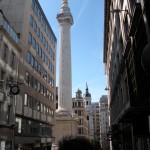
-
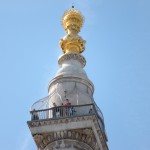
left overs of the Roman occupation, but rather creations of the 16th and 17th centuries, and while we no longer see forums or bath houses, we only need to look to realize that the founders of this city are not as distant as we thought.
Tags: Campbell










